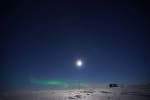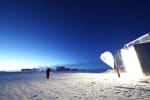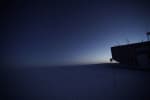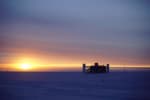The third edition of the IceCube Impact Awards was celebrated during the banquet dinner of the spring collaboration meeting last week in Madison. The awardees for this meeting are Joshua Wood of the University of Wisconsin–Madison, Tessa Carver of the University of Geneva, and Michael Larson of the University of Copenhagen, and the legacy award goes to Chris Weaver for his long-term contributions as a PhD candidate at UW–Madison and later as a postdoc at the University of Alberta. […]
News
Week 16 at the Pole
The extreme environment of the South Pole poses numerous challenges for those who work there, especially during the winter. One difficulty is simply dealing with things that break. You can’t just order a replacement online. […]
Week 15 at the Pole
It’s not the first aurora of the season, but it is the first one to be captured on camera by IceCube winterover Kathrin—a pretty, swirling aurora along the horizon, with a bright moon illuminating the icy surface from above. […]
The IceCube Collaboration meets again in Madison
The Wisconsin IceCube Particle Astrophysics Center (WIPAC) is pleased to host the IceCube Collaboration 2019 spring meeting. The meeting begins today, April 30, and runs through May 4. […]
Week 14 at the Pole
The sky was still bright enough last week to take a photo of an ozone balloon launch, the first one to send up a special plastic balloon in the hopes of a better survival as it ascends in the cold atmosphere. […]
A new edition of the IceCube Masterclass makes new connections with students
The sixth edition of the IceCube Masterclass hosted over 150 students at 13 institutions in Belgium, Germany, Switzerland, and the United States. The masterclasses were held on January 30, March 20, April 4 and April 11. […]
Week 13 at the Pole
There’s still just a bit of sunlight lingering, as seen in the image—what’s not so easily discernible in the image are the stars, but the winterovers report having seen them for the first time in months. […]
Week 12 at the Pole
Although the sun has set and winter has begun, it takes a while before it actually gets dark at the South Pole. Twilight is a prolonged process there, lasting weeks. Here there’s still plenty of daylight to see the station as it starts to look nice and frosty without direct sunlight. […]
Week 11 at the Pole
IceCube’s winterovers had the good luck to enjoy clear weather last week. They were able to capture some dramatic photos of the sunset. […]
Week 10 at the Pole
As the sun sinks low behind the IceCube Lab, the building’s shadow grows long—it’s almost reaching the South Pole Telescope, as shown here. […]









